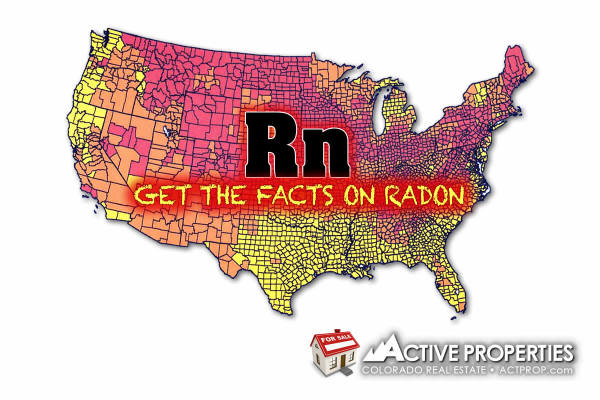Radon: there are possible risks to consider when purchasing or selling real estate along the front range, and mountain property in Colorado.
EPA estimates that about 20,000 lung cancer deaths each year in the U.S. are radon-related. Exposure to radon is the second leading cause of lung cancer after smoking. Radon is an odorless, tasteless and invisible gas produced by the decay of naturally occurring uranium in soil and water. Radon is a form of ionizing radiation and a proven carcinogen. Lung cancer is the only known effect on human health from exposure to radon in air. Thus far, there is no evidence that children are at greater risk of lung cancer than are adults.
Radon in air is ubiquitous. Radon is found in outdoor air and in the indoor air of buildings of all kinds. EPA recommends homes be fixed if the radon level is 4 pCi/L (picocuries per liter) or more. Because there is no known safe level of exposure to radon, EPA also recommends that Americans consider fixing their home for radon levels between 2 pCi/L and 4 pCi/L. The average radon concentration in the indoor air of America’s homes is about 1.3 pCi/L. It is upon this level that EPA based its estimate of 20,000 radon-related lung cancers a year upon. It is for this simple reason that EPA recommends that Americans consider fixing their homes when the radon level is between 2 pCi/L and 4 pCi/L. The average concentration of radon in outdoor air is .4 pCi/L or 1/10th of EPA’s 4 pCi/L action level.
For smokers the risk of lung cancer is significant due to the synergistic effects of radon and smoking. For this population about 62 people in a 1,000 will die of lung-cancer, compared to 7.3 people in a 1,000 for never smokers. Put another way, a person who never smoked (never smoker) who is exposed to 1.3 pCi/L has a 2 in 1,000 chance of lung cancer; while a smoker has a 20 in 1,000 chance of dying from lung cancer. Figure A compares the risks between smokers and never smokers; smokers are at a much higher risk than never smokers, e.g., at 8 pCi/L the risk to smokers is six times the risk to never smokers.
The radon health risk is underscored by the fact that in 1988 Congress added Title III on Indoor Radon Abatement to the Toxic Substances Control Act. It codified and funded EPA’s then fledgling radon program. Also that year, the Office of the U.S. Surgeon General issued a warning about radon urging Americans to test their homes and to reduce the radon level when necessary (U.S. Surgeon General).
Unfortunately, many Americans presume that because the action level of radon is 4 pCi/L, a radon level of less than 4 pCi/L is “safe”. This perception is altogether too common in the residential real estate market. In managing any risk, we should be concerned with the greatest risk. For most Americans, their greatest exposure to radon is in their homes; especially in rooms that are below grade (e.g., basements), rooms that are in contact with the ground and those rooms immediately above them.
CLICK HERE to access the EPA site regarding Radon
CLICK HERE for the EPA radon gas map
Additional Radon related articles:
Radon, and Granite Counter Tops
Radon – Radon Zones & National Map
Radon Testing – New or Current Home
Cliff Daniels
Active Properties
720 434 1418
Boulder Colorado






Hi, I desire to subscribe for this webpage to take latest updates,
therefore where can i do it please assist.
Stop by my homepage zehui jockstrap g string
Home page: “Get Our Newsletter”
I’m curious to find out what blog platform you have been utilizing?
I’m experiencing some small security problems with my latest blog and I’d like to
find something more risk-free. Do you have any suggestions?
my site … wayfarer sunglasses zigzag design